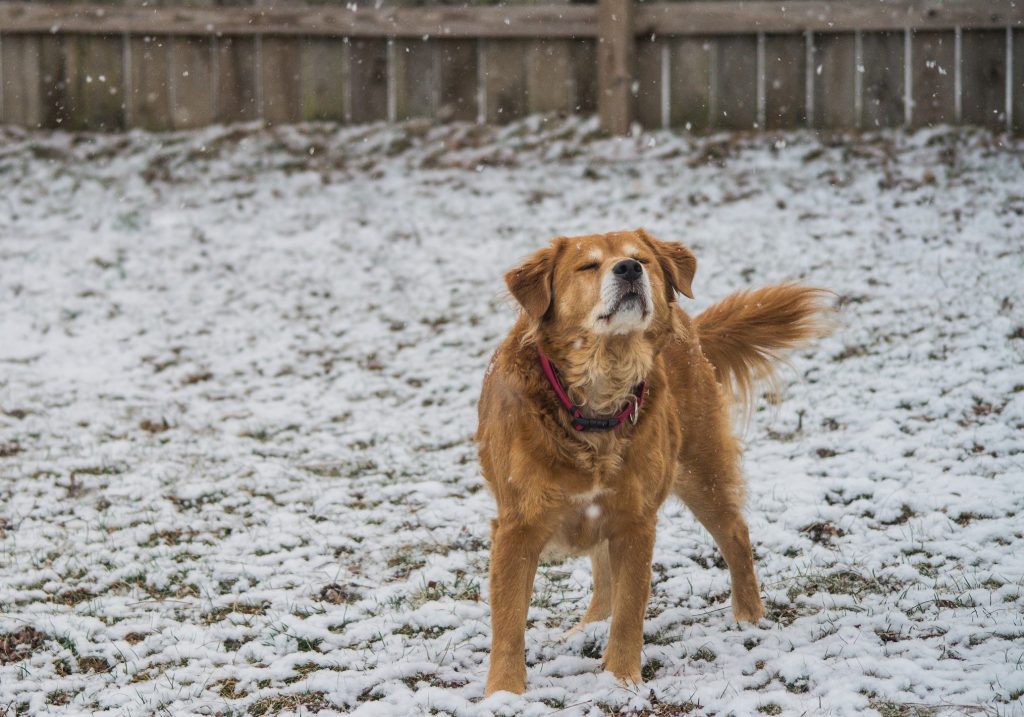Table of Contents

Disclaimer: I am not a vet, but an enthusiastic pet owner with a diverse knowledge of dogs, cats and other pets. Writing well researched articles recommending dog friendly products to in-depth guides. Please seek a certified vet for a professional opinion on your dog, these articles are written from my own research and opinions. Please read our Terms and Conditions for more! As an Amazon associate I earn from qualifying purchases.
Historically, fleas have been considered a warm weather problem, and we’ve known for a long time that these irksome little insects don’t do well with the cold. Even today, many pet owners are under the impression that fleas die in the winter. Some may even choose not to provide flea protection for their dogs during the winter months, due to this belief.
But is it true that fleas die in the winter? Or is this a myth? To answer the question of whether or not fleas die in the winter, we first need to take a quick look at the different stages of the flea life cycle. It’s also helpful to know that by far the most common type of flea in the United Kingdom and the United States is actually the cat flea, “Ctenocephalides felis”.
Despite it’s name, this pesky little insect is far more frequently responsible for itchy dogs than it’s cousin the dog flea (‘Ctenocephalides canis’), which is actually relatively uncommon. In fact, over 90% of canine flea infestations in the UK are actually caused by the cat flea!
How does the flea cycle work?
The flea life cycle starts when a female adult flea feeds upon a mammalian host (such as your dog), and then lays up to 50 eggs per day. These eggs hatch into flea larvae, which are maggot-like in appearance when examined using a magnifying glass (since they are too small to easily see with the naked eye).
Flea larvae feed on dirt and detritus in the environment for 5-20 days, before forming flea pupae. Picture a caterpillar forming a protective cocoon in order to become a butterfly, and you’ll achieve a pretty good visual image of the process by which a flea larva becomes a pupa.
Here’s where things get interesting, because the pupal stage is by far the craftiest contributor to the flea’s master plan! The flea pupa is able to remain in the environment – for example, your home – for more than a year if necessary. An adult flea will only hatch when a suitable host, such as a dog or cat, is present in the environment.
Now that you understand each unique stage of the flea lifecycle, let’s take a look at how each of these stages fare when winter sets in and things get chilly!
Do adult fleas die in winter?
Adult fleas can survive for several days in temperatures as low as 7.8℃ (46℉), although they certainly won’t appreciate this degree of cold; a balmy 23.9℃ / 75℉ is their preferred climate. Of course, many parts of the United Kingdom reach far colder temperatures than 7.8℃ in the winter months (just ask anybody from the north!), so surely in chillier regions our canine companions will be safe during the coldest times of the year?
Well, that would be the case, were it not for a little thing called central heating. This is the twenty-first century after all, and (cost of living crisis aside) we enjoy the luxury of year-round climate control within our homes. Most houses and apartments remain within a comfortable range for all life stages of the flea to thrive, even in the bleakest of midwinter.
Adult fleas are nothing if not opportunists, and they take advantage of this fact, surviving comfortably on our pets and in our centrally heated homes and merrily spewing out hundreds of new baby fleas all year round, even in winter.

Credit Unsplash.com User @Unkown
Do flea larvae die in the winter?
Flea larvae appreciate spending their days in a toasty 21.1 – 32.2℃ (70 – 90℉) environment, but they are able to survive and develop into flea pupae at temperatures as low as 13℃ (55℉). They will perish quite rapidly when exposed to temperatures below this, though.
Do flea pupae die in the winter?
Flea pupae are known to be able to survive for a very long time (up to 30 weeks!) at 11℃ (75℉). Below this temperature pupae may become too damaged to hatch, effectively killing the developing flea inside it’s protective cocoon.
But of course, in an artificially warmed environment such as a house or apartment building, flea pupae will have no trouble surviving the winter.
Can flea eggs survive the winter?
Contrary to popular belief, flea eggs are not found on the skin of the host dog or cat, but rather are found in the pet’s environment: most frequently in pet beds or on other soft furnishings where the pet is allowed to spend time (including the owner’s beds!)
Flea eggs are also often found tucked away between the fibers of carpets, and in cracks and crevices in skirting boards and between floorboards.
Like flea larvae, flea eggs are not able to survive temperatures below 13℃ (55℉), however they will certainly survive and hatch in winter within a heated home.
Do I need to treat my pet for fleas in the winter?
Even if you live in a geographic region where outside temperatures in winter are close to freezing, you will still need to provide pet dogs with flea protection (assuming you live in a home which is artificially heated to a comfortable living temperature).
If (like most) your home maintains a year-round temperature range between 13 – 32℃ (55 – 89.6℉), fleas will be able to complete their full life cycle from start to finish, and rapidly multiply in number resulting in a full-blown flea infestation.
So, to avoid any unwanted Christmas visitors (of the insect kind), it really is best to cover all dogs and cats in the household with flea protection all year round…even in the winter months.
Key take away points
- The flea’s preferred temperature is around 23.9℃ / 75℉, although they are able to comfortably complete their lifecycle anywhere between 13-32℃ (55 – 89.6℉).
- No stage of the flea life cycle is able to survive temperature below freezing (i.e., below 0℃ (32℉). Adults, eggs, larvae and even pupae will be destroyed quickly at sub-zero temperatures.
- To prevent flea infestations in your dog in winter, it is important to ensure all dogs and cats in the household are kept up to date with an effective flea protection product at all times…even in the winter months.
FAQ
Q: Are fleas and ticks the same?
No, fleas and ticks are not the same. They are two different types of parasitic insects. Fleas are able to jump from their host to another and can invest all types of animals, not just dogs. Ticks however, are commonly found in wooded areas with longer grass. Ticks are not able to jump, but rather crawl onto their targets. Ticks are known for becoming engorged as they feed on the blood of their hosts, hence the round body.
Q: Which breeds do fleas like the most?
Fleas do not necessarily prefer specific breeds of dogs over others. Instead, fleas are attracted to warm-blooded animals, including dogs, due to their body heat, movement, and the availability of blood to feed on. But dogs that enjoy the outside, have longer fur and dogs with lower immune systems are more susceptible to getting fleas.
Q: Can Labradors get fleas?
Labradors, like all dogs, can get fleas if exposed to them. Their warm bodies and fur make them attractive hosts for fleas to feed on. Regular preventive measures, such as flea treatments recommended by veterinarians, can help keep Labradors and their owners protected from flea infestations.
Q: Are fleas harmful to humans?
Fleas usually don’t cause any harm to humans. Although they may leave bites or a rash which may irritate skin. But some fleas can carry diseases, so it’s worth being careful even when you are bitten.
Q: Do fleas die on their own?
Although fleas can die on their own, it’s unlikely they will die without being properly treated.
Q: How do you know if your dog has fleas?
Together with itching, you may notice red bumps or pimples around your dogs legs or on their belly. The base of their tail may also have red marks. If your dog is losing hair, this is another telling sign they are itching too much and have fleas. It’s best to treat them as soon as possible.


2 thoughts on “Do Fleas Die In The Winter?”
Comments are closed.